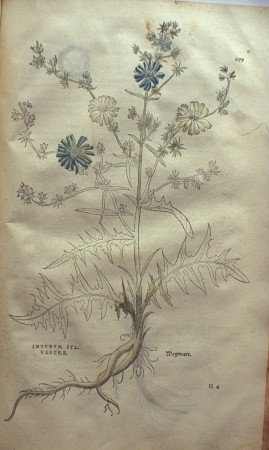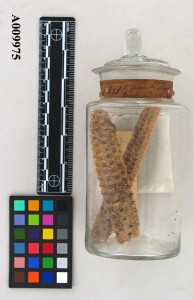- Clovefield.
- They Eat Invasives, Don’t They?
- The Wrong Seeds.
- Seeds of One’s Own.
- Bee Photographs.
- Clay Pigeons.
Ancient wild relatives
While we’re on the subject of radicchio diversity, old Roman medicines and the like, we were pleased to be sent a link to Renaissance Herbals, a collaboration between the Smithsonian Institution and the Biblioteca Nazionale Centrale di Roma. There are some lovely images to peruse and use, like this one, of wild chicory, Cichorium intybus.:

One could complain, of course, that the links between the illustrations and other sorts of information are non-existent. But hey, you can’t have everything.
More on ancient Roman pills
What I missed when I wrote about the 2000-year-old Roman pills a couple of days back is that the research was highlighted by Discover magazine as one of the Top 100 Stories of 2010. In addition, Emanuela Appetiti, one of the researchers involved, kindly pointed me to a story at AoLNews which has lots more photos and another one in the Washington Post. She also gave me this nice bit of news:
…I am happy to inform you that Alain Touwaide and myself, along with Rob Fleischer, the geneticist who did the DNA analysis of the ancient medicines, will be in Rome in mid-May 2011 (on the occasion of the “Night of the Museums”) to present at “La Sapienza” University this research. For the first time, we’ll be all there: the three of us and the staff of the Soprintendenza di Firenze, who did the archeaological digging and first analysis. The event in Rome will be on May 14, 2011, at the faculty of Letters.
Looking forward to that. In the meantime, here’s a very recent interview with Alain Touwaide, courtesy of the BBC. Thanks, Emanuela.
Nibbles: Biofuels, Avocado, Seed systems, Himalaya, Umbria
- Corn and ethanol, sitting in a tree … it’s complicated.
- More than anyone — except us — could ever want to know about the avocado. h/t Nicola.
- FAO prescribes seed systems for small farmers. h/t CIAT blog.
- Slides about agricultural biodiversity in the Himalaya; wish I knew what to make of it, if anything.
- Umbria says “COLTIVIAMO LA BIODIVERSITÀ“.
Test question (no prizes): What’s the link between avocados and orchids?
Great ethnobotanical collection online
 Another great find from the recent issue of The Plant Press I blogged about yesterday is the Smithsonian’s website on Edward Palmer:
Another great find from the recent issue of The Plant Press I blogged about yesterday is the Smithsonian’s website on Edward Palmer:
Edward Palmer (1831-1911), often regarded as “the father of ethnobotany,” gathered extensive natural history collections in North and South America during the late nineteenth century and established standards for plant collecting and reporting, particularly for plants useful to people. His scientific framework is still used today. This new Botany website, Edward Palmer Collections provides a window into the Palmer Collection to communities where Palmer originally collected, as well as to scientists and the general public.
Palmer held posts both as ethnologist for the Smithsonian and as USDA plant collector, and the connections between his botanical and anthropological materials are fascinating, and nicely highlighted on the website. Now, is anyone going to try to get DNA out of his corncob?